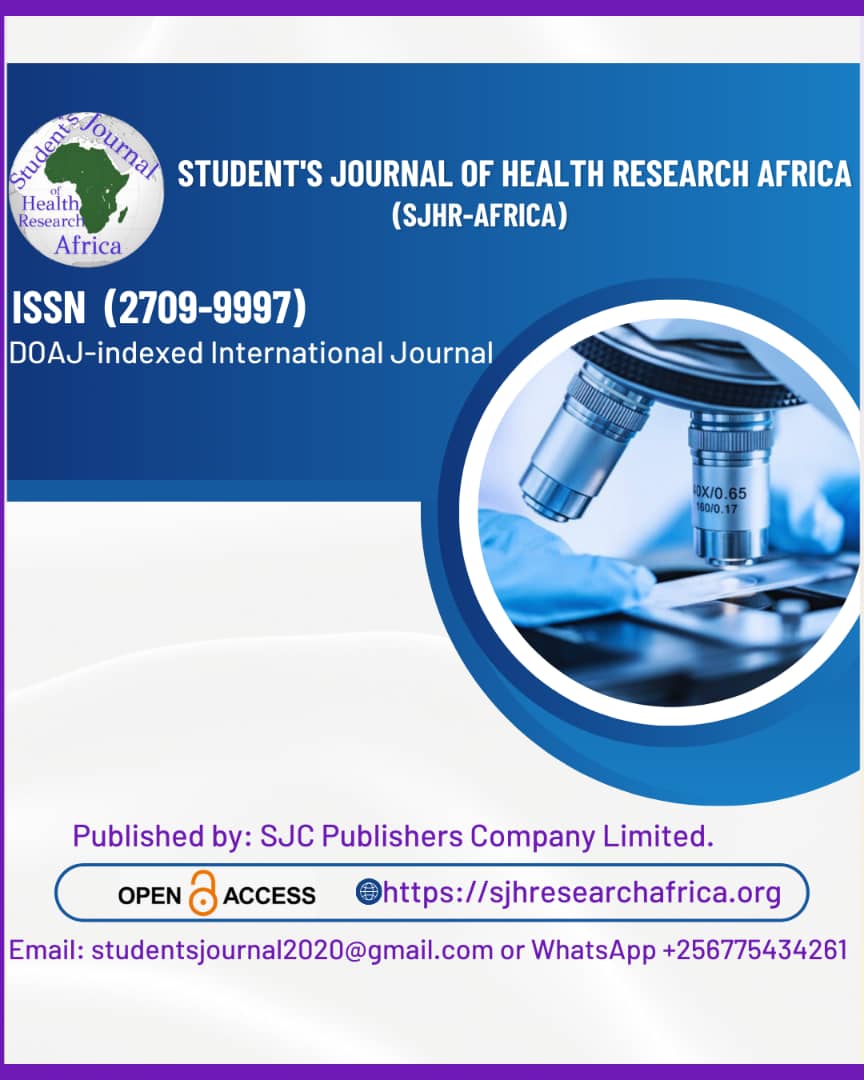DRUG UTILISATION, ADVERSE DRUG REACTION PROFILE AND TREATMENT OUTCOME OF PNEUMONIA IN UNDER-FIVE CHILDREN IN A TERTIARY CARE HOSPITAL: A CROSS-SECTIONAL STUDY.
DOI:
https://doi.org/10.51168/sjhrafrica.v6i3.1717Keywords:
Drug utilisation pattern, Polypharmacy, Rational Antimicrobials, Under five pneumonia, WHO-UMCAbstract
Backgrounds
Childhood pneumonia is a leading cause of morbidity and mortality among children under 5 years old worldwide. Despite global efforts to prevent and manage this condition, the improper and irrational use of antimicrobials is one of the greatest hinderance to achieving the target.
Objectives: The study aimed to evaluate the drug utilization pattern, treatment outcome, and monitoring of frequency and severity of Adverse Drug Reactions (ADRs) with its causality assessment among under-five pneumonia cases.
Methods
This observational cross-sectional study was conducted on 118 diagnosed cases of pneumonia aged 2 months to 5 years. Data were collected from treatment records and parents' responses and analyzed using Microsoft Excel 2016 and SPSS version 22.0.
Results
Among 118 under-five pneumonia cases, 88.1% recovered and 11.9% required ICU care. Most were male (75.4%), aged 2–12 months (60.2%), and from rural areas (73%). Complications were linked to female gender and parental smoking. Adverse outcomes were associated with fever, cough, delayed treatment, prolonged hospitalization, and multiple antibiotic use. Prescription analysis (536 cases) showed polypharmacy (mean 4.52 drugs), universal antibiotic, and injection use, with 85.92% prescribed by generic name and 88.93% from the essential drug list. Of 50 ADRs, diarrhea (58%) from ceftriaxone was most common.
Interpretation: Female gender and parental smoking were associated with higher ICU admissions, highlighting the need for targeted clinical strategies in managing pediatric pneumonia.
Conclusion
The study concluded that prompt and appropriate treatment is pivotal for resolving pneumonia in children and reducing morbidity and mortality. Monitoring prescriptions and drug utilization studies helps in detecting and reducing irrational prescribing while offering feedback to prescribers.
Recommendation
Raising awareness among healthcare providers and caregivers, regularly educating on proper antibiotic use, implementing prescribing guidelines, and involving patients in ADR reporting can enhance treatment outcomes and minimize adverse drug reactions in under-five pneumonia cases.
References
Kwame Wiredu, MD, Childhood Pneumonia A Literature Review.
Mathew, J.L. et al. (2011) “Acute respiratory infection and pneumonia in India: A systematic review of literature for advocacy and action: UNICEF-PHFI series on newborn and child health, India,” Indian Pediatrics, 48(3), pp. 191–218. Available at: https://doi.org/10.1007/s13312-011-0051-8.
Madhusudhan K, Sreenivasaiah B, Kalivela S, Nadavapalli SS, Babu RT, Jampana VR. Clinical and bacterial profile of pneumonia in 2 months to 5 years age children: a prospective study done in a tertiary care hospital. Int J Contemp Pediatrics 2017; 4:90-5
WHO. Recommendations for management of common childhood conditions: Evidence for technical update of pocketbook recommendations. Geneva, WHO, 2012. http://www.who.int/maternal_child_adolescent/documents/management_childhood_ conditions/en/index.html
https://www.who.int/news-room/fact-sheets/detail/pneumonia. Last updated on 2nd august 2019. Last seen 8thfeb 2021
World Health Statistics. Geneva: WHO; 2007. Available from: http://www.who.int/whosis/whostat2007.pdf. Accessed 1 Jan 2018.
Champatiray, J. (2017) “Clinico-Aetiological Study of severe and very severe pneumonia in two months to five years children in a tertiary health care centre in Odisha, India,” JOURNAL OF CLINICAL AND DIAGNOSTIC RESEARCH. Available at: https://doi.org/10.7860/jcdr/2017/26027.10595.
Vinod k paul | Ghai, O.P. (2010) Essential pediatrics. New Delhi: CBS Publishers and distributors Pvt. Ltd. Ch 14 pg no 377-380
Palikhe. N. Prescribing Pattern of antibiotics in pediatrics hospital of Kathmandu Valley. J Nepal Health Research council 2004;(2):31-36.
Bernadeta Dadonaite and Max Roser (2018) - "Pneumonia". Published online at OurWorldInData.org. Retrieved from: 'https://ourworldindata.org/pneumonia' [Online Resource]
Mitike G. Pneumonia in under-five children. East African Medical Journal, 2001; 32: 18-24
Chavda DA, Mistry RA, Solanki KC, Suthar SD, Desai BL, Mistry SD. Drug utilization study in the inpatients of paediatric department of a tertiary care hospital. Int J Basic Clin Pharmacol 2015; 4:729-33
K.M., M.A.A. and., G.kishore (2012) “Study of prescribing pattern of antibiotic in pediatric patients with pneumonia,” Journal of Applied Pharmacy, 4, pp. 204–211. Available at: https://doi.org/10.21065/19204159.4.204.
N. VENKATESWARAMURTHY, R. MURALI*, R. SAMPATH KUMAR. THE STUDY OF DRUG UTILIZATION PATTERN IN PEDIATRIC PATIENTS: International Journal of Pharmacy and Pharmaceutical Sciences; Vol 5, Issue 3, 2013
Sarkar, S. (2018) “Integrated management of neonatal and childhood illness (IMNCI),” Pediatric Nursing, pp. 228–228. Available at: https://doi.org/10.5005/jp/books/14185_11 last accessed on 6th November,2022
World Health Organization. How to investigate drug use in health facilities: selected drug use indicators. 1993. http://apps.who.int/medicinedocs/en/d/ Js2289e/. Accessed 18 Oct 2015.
Hassan MZ, et al. BMJ Global Health 2021;6: e004010. doi:10.1136/bmjgh-2020-00401
James S. Pneumonia bacterial. Journal New England Medical center E-medicine 2007;2(2):2.
Patel, N., Patel, D. and Desai, H. (2019) “Antimicrobial utilization pattern among pediatric inpatients of a tertiary care hospital in Central Gujarat,” National Journal of Physiology, Pharmacy and Pharmacology, p. 1. Available at: https://doi.org/10.5455/njppp.2019.9.0933406102019.
SK, A. and Y, H. (2021) “Drug utilization study on pediatric pneumonia patients in a tertiary care teaching hospital,” International Journal of Health Care and iological Sciences, pp. 70–74. Available at: https://doi.org/10.46795/ijhcbs.v2i4.249.
MaxiMilian Munchoff and Philip J.R. Goulder et al., sex differences in pediatric infectious diseases, 2014:2019
Shankar PR, Upadhyay DK, Subish P, Dubey AK, Mishra P. Prescribing patterns among paediatric inpatients in a teaching hospital in western Nepal. Singapore Med J. 2006; 47:261-5
Issac AJ, Yogananda R, Mohamed Shehin T. Assessment of prescription pattern and monitoring adverse drug reaction of antibiotics in paediatric inpatients. Int J Contemp Pediatr 2016; 3:1071-5
Muslim, Z. (2018) “Antibiotic prescription to pediatric in hospital Bengkulu, Indonesia: ATC/DDD index,” International Journal of Pharmacy and harmaceutical Sciences, 10(5), p. 31. Available at: https://doi.org/10.22159/ijpps.2018v10i5.25291.
Shamshy K, Mufida IB, Perumal P. Drug Utilization of Antimicrobial drug in Pediatrics Population in a tertiary care hospital in Erode, Tamilnadu, India. International Journal of PharmTech Research. 2011;3(3):1530-36
Khan, Z.; Karata¸s, Y.; Kıro ˘glu, O. Evaluation of Adverse Drug Reactions in Paediatric Patients: A Retrospective Study in Turkish Hospital. Front. Pharmacol. 2021, 12, 786182.
Rani, N. Pattern of Adverse Drug Reactions Among Pregnant Women and Pediatric Patients in a Tertiary Care Hospital. Curr. Drug Saf. 2022. Epub ahead of print
Safety of Antibiotics in Hospitalized Children in Romania: A Prospective Observational Study Noémi-Beátrix Bulik 1, †, Andreea Farcas, 2,* ,† , Camelia Bucs, a 2,† , Irina Iaru 3,† and Ovidiu Oniga 1
Downloads
Published
How to Cite
Issue
Section
License
Copyright (c) 2025 Snehasini Dash, Suvendu Kumar Panda, Jayanti Prava Behera, Pratyush Mishra

This work is licensed under a Creative Commons Attribution-NonCommercial-NoDerivatives 4.0 International License.






















